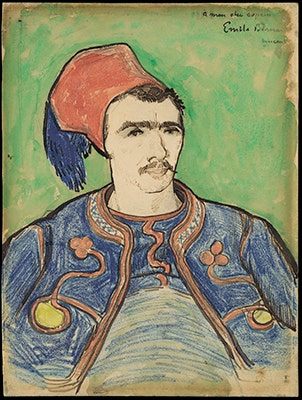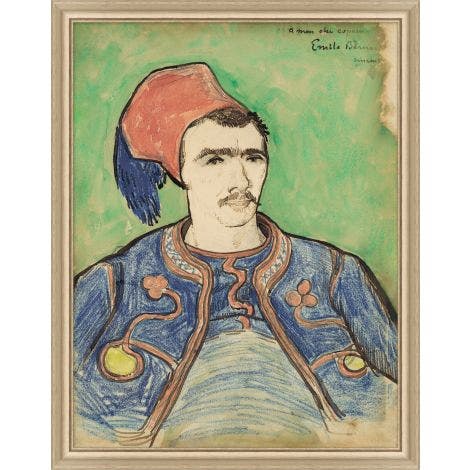Local Storage seems to be disabled in your browser.
For the best experience on our site, be sure to turn on Local Storage in your browser.
The Zouave

Our Inspiration:The Zouave
Vincent van Gogh (Dutch, 1853–1890)
Reed pen and brown ink, wax crayon, and watercolor,
over graphite on wove paper; 12 3/8 x 9 5/16 in., 1888
Gift of Emanie Philips, 1962 62.151
During a spell of torrential rain that interrupted his harvest series, Van Gogh made his first real effort at portraiture in Arles. Two days into his campaign, he announced to his brother Theo: “I have a model at last—a Zouave—a boy with a small face, a bull neck, and the eye of the tiger.” The present work served as a color study for his bust-length portrait of the dashing young soldier. In the oil painting, Van Gogh heightened the “savage combination of incongruous tones,” fleshed out the character’s likeness, and placed him in a convincing setting.

Our Inspiration:The Zouave
Vincent van Gogh (Dutch, 1853–1890)
Reed pen and brown ink, wax crayon, and watercolor,
over graphite on wove paper; 12 3/8 x 9 5/16 in., 1888
Gift of Emanie Philips, 1962 62.151
During a spell of torrential rain that interrupted his harvest series, Van Gogh made his first real effort at portraiture in Arles. Two days into his campaign, he announced to his brother Theo: “I have a model at last—a Zouave—a boy with a small face, a bull neck, and the eye of the tiger.” The present work served as a color study for his bust-length portrait of the dashing young soldier. In the oil painting, Van Gogh heightened the “savage combination of incongruous tones,” fleshed out the character’s likeness, and placed him in a convincing setting.



